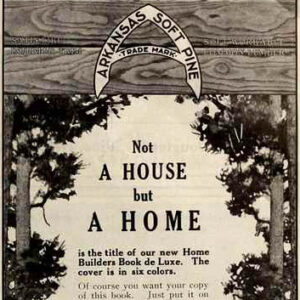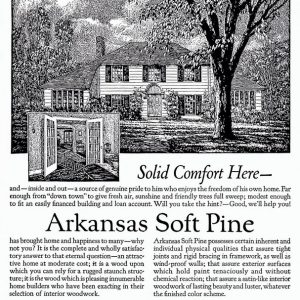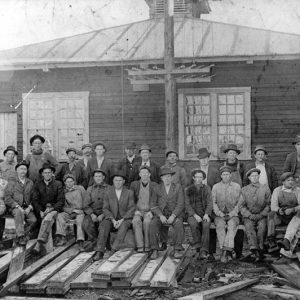calsfoundation@cals.org
Arkansas Soft Pine Bureau (ASPB)
Founded in 1912 by executives of a dozen prominent Arkansas timber firms, the Arkansas Soft Pine Bureau (ASPB) spent decades promoting its members’ southern pine lumber. American Lumberman ad salesman Robert H. Brooks originally conceived of the ASPB, using his previous experience with these firms to convince them to try a one-year advertising campaign funded by an assessment of five cents per 1,000 board feet of lumber manufactured in their Arkansas mills. The first ASPB advertisements appeared in October 1912 and proved successful enough that, by the spring of 1913, the ASPB principals initiated a national campaign and coined the term “Arkansas Soft Pine”—a description patented in 1921 as a registered trademark.
Brooks, a Kansan with previous experience in the retail lumber business, initially operated the bureau out of Chicago, Illinois, but when the frequent long trips to Arkansas took a toll, he moved to Little Rock (Pulaski County) and, in 1915, opened the Robert H. Brooks Advertising Agency with the ASPB as the firm’s first client. The ASPB emphasized the quality of the southern pine lumber produced by its members. ASPB’s trademarked “Big A” symbol was placed on products that upheld the bureau’s standards. The ASPB touted Arkansas Soft Pine—a mixture of shortleaf (Pinus echinata) and loblolly (Pinus taeda) pines—as preferable to the harder, denser, and heavier wood of longleaf pine (Pinus palustris). For instance, the ASPB claimed that the less resinous wood of Arkansas Soft Pine had a better surface for painting and staining than longleaf pine, making it superior for trim work and finish carpentry.
Over the years, the ASPB produced a number of publications to help foster demand. As an example, in 1918, the ASPB issued a popular thirty-two-page pamphlet titled, “The Home You Longed For,” that included floor plans of homes designed by noted Chicago architect Robert Seyfarth. Other publications by the ASPB included handbooks on the engineering properties of their products intended for lumber retailers and homebuilders. In addition, the ASPB produced single-page advertisements that featured idyllic scenes of families enjoying homes built of Arkansas Soft Pine. One booklet (“The Boy’s Own Builder”) was even targeted to Boy Scouts. The ASPB also sponsored numerous contests over the years for architects and builders, awarding cash prizes to the winners and incorporating the winner’s designs in ASPB advertising campaigns.
Over the years, the membership of the ASPB varied with the fortunes of the industry, but at some point included Arkansas Land and Lumber Company of Malvern (Hot Spring County), Arkansas Lumber Company of Warren (Bradley County), Cotton Belt Lumber Company of Bearden (Ouachita County), Bradley Lumber Company of Warren, Caddo River Lumber Company of Glenwood (Pike County), Crossett Lumber Company of Crossett (Ashley County), Dierks Lumber and Coal Company of Dierks (Howard County), Eagle Lumber Company of Eagle Mills (Ouachita County), Edgar Lumber Company of Wesson (Union County), Fordyce Lumber Company of Fordyce (Dallas County), Freeman-Smith Lumber Company of Millville (Ouachita County), Frost Lumber Industries of Huttig (Union County), Gates Lumber Company of Wilmar (Drew County), Ozan-Graysonia Lumber Company of Prescott (Nevada County), Potlatch Corporation of Warren, Southern Lumber Company of Warren, Stout Lumber Company of Thornton (Calhoun County), and Wisconsin and Arkansas Lumber Company of Malvern. In the early twentieth century, such widespread corporate cooperation sometimes led to charges of collusion and price fixing. A federal anti-trust lawsuit along these lines was filed in 1921 against a number of key players in the southern pine industry, including some in the ASPB, but little came of the litigation.
In 1942, Brooks added Al Pollard as a partner, renaming his advertising firm the Brooks-Pollard Company. Brooks remained the executive director of the ASPB until his retirement in 1957, when Pollard succeeded him. The ASPB continued to market Arkansas Soft Pine to a range of consumers and, by the time of Brooks’s departure, had spent about $3 million in its promotional efforts.
Market forces and the dynamics of the forest products industry eventually led to the demise of the ASPB. According to a 1975 article in Southern Lumberman, membership in the ASPB declined as family-owned timber companies were acquired by large, multinational firms, which did not generally share the same desire to promote Arkansas Soft Pine as a unique product. It appears that the ASPB ceased operations in the mid- to late 1970s, as a 1979 southern pine lumber marketing analysis for Arkansas by professors G. Edward Kiser and C. P. Rao, both of the University of Arkansas (UA) in Fayetteville (Washington County), failed to mention the ASPB.
For additional information:
“Arkansas Group’s Promotion Profitable.” Southern Lumberman 195 (December 15, 1957): 136–137.
“‘Arkansas Soft Pine’ Now a Registered Term.” Lumber 68 (September 30, 1921): 34a.
Arkansas Soft Pine Bureau. The Arkansas Soft Pine Hand Book. Little Rock: Robert H. Brooks Advertising Agency, 1919.
Arkansas Soft Pine Bureau. The Arkansas Soft Pine Hand Book: Wood Mouldings and Universal Sizes. Little Rock: Robert H. Brooks Advertising Agency, 1925.
Arkansas Soft Pine Bureau. “The Home You Longed For.” Little Rock: Robert H. Brooks Advertising Agency, 1918.
Kiser, G. Edward, and C. P. Rao. Marketing Southern Pine Lumber in Arkansas. Fayetteville: University of Arkansas, College of Business Administration, Department of Marketing and Transportation, December 1979.
Long, Thomas M. “Arkansas Soft Pine Bureau Story: Its Sixty Years of Service.” Southern Lumberman 231 (December 15, 1975): 52–54.
Don C. Bragg
USDA Forest Service
Southern Research Station
 Early Twentieth Century, 1901 through 1940
Early Twentieth Century, 1901 through 1940 Arkansas Soft Pine Ad
Arkansas Soft Pine Ad  ASPB Ad
ASPB Ad  Millville Sawmill
Millville Sawmill 




Comments
No comments on this entry yet.